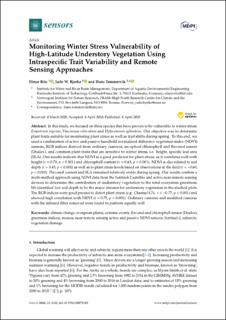| dc.contributor.author | Ritz, Elmar | |
| dc.contributor.author | Bjerke, Jarle W. | |
| dc.contributor.author | Tømmervik, Hans | |
| dc.date.accessioned | 2020-04-20T12:00:00Z | |
| dc.date.available | 2020-04-20T12:00:00Z | |
| dc.date.issued | 2020 | |
| dc.identifier.issn | 1424-8220 | |
| dc.identifier.uri | https://hdl.handle.net/11250/2651679 | |
| dc.description.abstract | In this study, we focused on three species that have proven to be vulnerable to winter stress:
Empetrum nigrum, Vaccinium vitis-idaea and Hylocomium splendens. Our objective was to determine plant traits suitable for monitoring plant stress as well as trait shifts during spring. To this end, we used a combination of active and passive handheld normalized di erence vegetation index (NDVI) sensors, RGB indices derived from ordinary cameras, an optical chlorophyll and flavonol sensor (Dualex), and common plant traits that are sensitive to winter stress, i.e. height, specific leaf area
(SLA). Our results indicate that NDVI is a good predictor for plant stress, as it correlates well With height (r = 0.70, p < 0.001) and chlorophyll content (r = 0.63, p < 0.001). NDVI is also related to soil depth (r = 0.45, p < 0.001) as well as to plant stress levels based on observations in the field (r = �����0.60, p < 0.001). Flavonol content and SLA remained relatively stable during spring. Our results confirm a
multi-method approach using NDVI data from the Sentinel-2 satellite and active near-remote sensing devices to determine the contribution of understory vegetation to the total ecosystem greenness.
We identified low soil depth to be the major stressor for understory vegetation in the studied plots.
The RGB indices were good proxies to detect plant stress (e.g. Channel G%: r = �����0.77, p < 0.001) and showed high correlation with NDVI (r = 0.75, p < 0.001). Ordinary cameras and modified cameras with the infrared filter removed were found to perform equally well. | en_US |
| dc.language.iso | eng | en_US |
| dc.rights | Navngivelse 4.0 Internasjonal | * |
| dc.rights.uri | http://creativecommons.org/licenses/by/4.0/deed.no | * |
| dc.subject | climate change | en_US |
| dc.subject | evergreen plants | en_US |
| dc.subject | extreme events | en_US |
| dc.subject | flavonol and chlorophyll sensor (Dualex) | en_US |
| dc.subject | greenness indices | en_US |
| dc.subject | mosses | en_US |
| dc.subject | near-remote sensing active and passive NDVI sensors | en_US |
| dc.subject | Sentinel-2 | en_US |
| dc.subject | subarctic vegetation damage | en_US |
| dc.title | Monitoring Winter Stress Vulnerability of High-Latitude Understory Vegetation Using Intraspecific Trait Variability and Remote Sensing Approaches | en_US |
| dc.type | Journal article | en_US |
| dc.description.version | publishedVersion | en_US |
| dc.rights.holder | © 2020 by the authors. | en_US |
| dc.subject.nsi | VDP::Matematikk og Naturvitenskap: 400::Zoologiske og botaniske fag: 480 | en_US |
| dc.source.volume | 20 | en_US |
| dc.source.journal | Sensors | en_US |
| dc.identifier.doi | 10.3390/s20072102 | |
| dc.identifier.cristin | 1807136 | |

